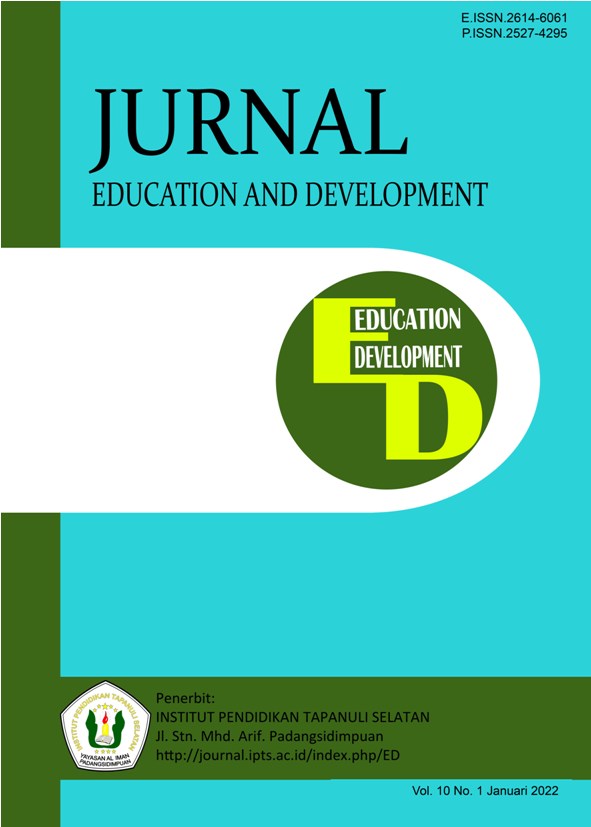HIGHER EDUCATION STUDENTS’ FOREIGN LANGUAGE ANXIETY: A CASE STUDY AT ENGLISH EDUCATION DEPARTMENT OF IAIN LANGSA
Main Article Content
Abstract
This study discusses EFL learners’ foreign language anxiety at a higher education institution in Langsa. It further explores factors that contribute to language apprehension and how it manifests in the students. This study employed a qualitative approach with the type of case study research. The subjects of this research were 10 students of the English Education Department of IAIN Langsa. The data were collected through observation, focus group discussion, and in-depth interviews. Data analysis techniques included data reduction, data presentation, and data conclusion. This study found that the majority of the students experienced anxiety in learning English as a foreign language. Factors that trigger anxiety include inadequate vocabulary and knowledge of grammar, unintelligible pronunciation, individual learning preferences, and afraid of negative evaluation. Some learners suffered various symptoms when practicing the target language, such as shaky hands, wobbly legs, stuttering, headache, and a sense of dread. Such factors affected their attitudes toward the foreign language learning, such as language inhabitant, demotivated, and worried in language classrooms. Nevertheless, few of them conducted efforts to deal with the anxiety include participating in the classroom activity, preparing notes before speaking, and learning with peers.
Article Details
References
Alcala, D. F. D. R. (2007). Self-Esteem and Foreign Language Learning: An introduction. In D. F. D. R. Alcala (Ed.), Self-esteem and foreign language learning (pp. 2–12). Newcastle: Cambridge Scholars Publishing.
Arnold, J. (2011). Attention to Affect in Language Learning. Online Submission, Anglistik: International Journal of English Studies, 22(1), 11–22.
Brown, H. D. (1997). Brown, H. D. (1997). Teaching by Priciples: An Integrative Approach to Language Pedagogy (3rd ed.). New York: Pearson Education.
Brown, H. D. (2007). Teaching by Principles, An Interactive Approach to Language Pedagogy. New York: Pearson Education.
Chou, M.-H. (2018). Speaking Anxiety and Strategy Use for Learning English as a Foreign Language in Full and Partial English-Medium Instruction Contexts. TESOL Quarterly, 52(3), 611–633. https://doi.org/10.1002/tesq.455
Cohen, L., Manion, L., & Morriosn, K. (2009). Research Methods in Education (Sixth Edit). London & New York: Routledge.
Faruq, A. Z. Al. (2019). Reading Anxiety in English As A Foreign Language for Undergraduate Students in Indonesia. TLEMC: Teaching and Learning English in Multicultural Contexts, 3(2), 88–95.
Gardner, R. C. (1985). Social Psychology and Second Language Learning: The Role of Attitude and Motivation. London: Edward Arnold.
Gardner, R. C., & MacIntyre, P. D. (1992). A student’s contributions to second language learning. Part I: Cognitive variables. Language Teaching, 24(4), 211–220. https://doi.org/10.1017/S026144480000700X
Ghufron, M. N., & Suminta, R. R. (2010). Teori-Teori Psikologi. Yogyakarta: Ar-Ruzz Media.
Hashemi, M., & Abbasi, M. (2013). The Role of the Teacher in Alleviating Anxiety in Language Classes. International Research Journal of Applied and Basic Sciences, 4(3), 640–646.
Horwitz, E. K., Horwitz, M. B., & Cope, J. (1986). Foreign Language Classroom Anxiety. The Modern Language Journal, 70(2), 125–132. https://doi.org/10.2307/327317
Humphries, R. (2011). Language Anxiety in International Students. Griffith Working Papers in Pragmatics and Intercultural Communication, 4(1/2), 65–77.
Jiang, Y., & Dewaele, J.-M. (2020). The predictive power of sociobiographical and language variables on foreign language anxiety of Chinese university students. System, 89(102207), 1–21. https://doi.org/10.1016/j.system.2020.102207
Kirova, S., Petkovska, B., & Kuzmanovska, D. (2012). Investigation of Motivation and Anxiety in Macedonia While Learning English as a Second/Foreign Language. Procedia - Social and Behavioral Sciences, 46, 3477–3481. https://doi.org/10.1016/j.sbspro.2012.06.088
Kratochwill, T. R., Cook, J. L., Travers, J. F., & Elliott, S. N. (1996). Educational Psychology: Effective Teaching, Effective Learning (Second Edi). Madition: Brown and Benchmark Company.
Macintyre, P. D. (1995). How Does Anxiety Affect Second Language Learning? A Reply to Sparks and Ganschow. The Modern Language Journal, 79(1), 90–99. https://doi.org/10.1111/j.1540-4781.1995.tb05418.x
Ohata, K. (2005). Language Anxiety from the Teacher’s Perspective: Interviews with Seven Experienced ESL/EFL Teachers. Journal of Language and Learning, 3(1).
Oxford, R. L. (1993). Research Update on Teaching L2 Listening. Sysrem, 21(2), 205-211,. https://doi.org/10.1016/0346-251X(93)90042-F
Prastiyowati, S. (2019). Anxiety onStudents’ Listening Comprehension in University Students in Malang. Celtic : A Journal of Culture, English Language Teaching, Literature and Linguistics, 6(1), 65–77. https://doi.org/https://doi.org/10.22219/celtic.v6i1.8758
Ramaiah, S. (2003). Kecemasan: Bagaimana Mengatasi Penyebabnya. Jakarta: Pustaka Obor Populer.
Sadighi, F., & Dastpak, M. (2017). The Sources of Foreign Language Speaking Anxiety of Iranian English Language Learners. International Journal of Education and Literacy Studies, 5(4), 111–115. https://doi.org/10.7575/aiac.ijels.v.5n.4p.111
Spielmann, G., & Radnofsky, M. (2001). Learning Language under Tension: New Directions from a Qualitative Study. The Modern Language Journal, 85(2), 259–278. https://doi.org/10.1111/0026-7902.00108
Sugiono. (2016). Metode Penelitian Kuantitatif, Kualitatif, dan R&D. Bandung: PT Alfabeta.
Szyszka, M. (2018). Pronunciation Learning Strategies and Language Anxiety: In Search of an Interplay. Cham: Springer International Publishing AG.
Walker, E. (1997). Foreign language anxiety in Hong Kong secondary schools: Its relationship with the age-related factors, school form and self-perception. Hongkong University.
Woodrow, L. (2006). Anxiety and Speaking English as a Second Language. RELC Journal, 37(3), 308–328. https://doi.org/10.1177/0033688206071315
Yayli, D. (2012). University Summer School Students’ Foreign Language Anxiety Levels. Procedia - Social and Behavioral Sciences, 46, 1401–1405. https://doi.org/10.1016/j.sbspro.2012.05.310
Young, D. J. (1990). An Investigation of Students’ Perspectives on Anxiety and Speaking. Foreign Language Annals, 23(6), 593–553. https://doi.org/10.1111/j.1944-9720.1990.tb00424.x
Young, D. J. (1991). Creating a Low-Anxiety Classroom Environment: What Does Language Anxiety Research Suggest? The Modern Language Journal, 75(4), 426–437. https://doi.org/10.1111/J.1540-4781.1991.TB05378.X

